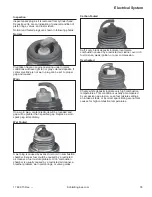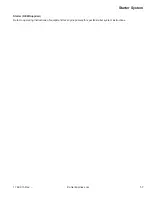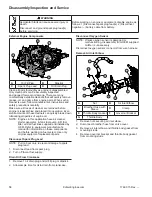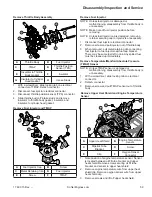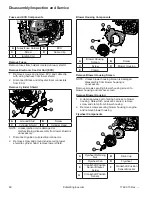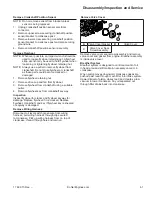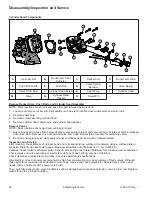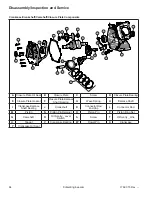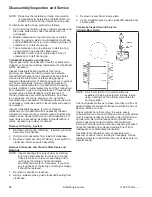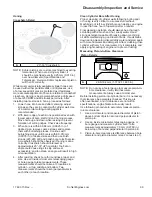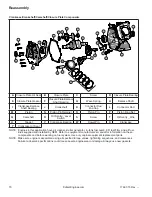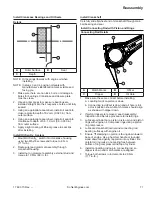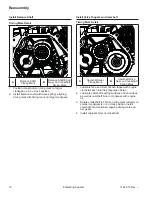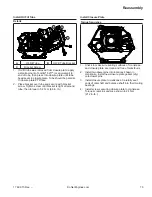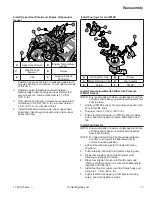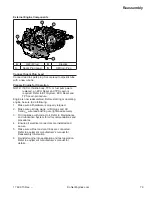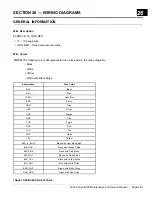
69
Disassembly/Inspection and Service
17 690 15 Rev. --
KohlerEngines.com
Honing
Crosshatch Detail
A
A
23°-33° Crosshatch
NOTE: Kohler pistons are custom-machined to exacting
tolerances. When over-sizing a cylinder, it
should be machined exactly 0.25 mm (0.010 in.)
over new diameter (Specifi cations and
Tolerances). Oversize Kohler replacement piston
will then fi t correctly.
While most commercially available cylinder hones can
be used with either portable drills or drill presses, use
of a low speed drill press is preferred as it facilitates
more accurate alignment of bore in relation to crankshaft
crossbore. Honing is best accomplished at a drill speed
of about 250 RPM and 60 strokes per minute. After
installing coarse stones in hone, proceed as follows:
1. Lower hone into bore and after centering, adjust
stones so they are in contact with cylinder wall. Use
of a commercial cutting-cooling agent is
recommended.
2. With lower edge of each stone positioned even with
lowest edge of bore, start drill and honing process.
Move hone up and down while resizing to prevent
formation of cutting ridges. Check size frequently.
3. When bore is within 0.064 mm (0.0025 in.) of
desired size, remove coarse stones and replace
them with burnishing stones. Continue with
burnishing stones until bore is within 0.013 mm
(0.0005 in.) of desired size and then use fi nish
stones (220-280 grit) and polish bore to its fi nal size.
A crosshatch should be observed if honing is done
correctly. Crosshatch should intersect at
approximately 23°-33° off horizontal. Too fl at an
angle could cause rings to skip and wear
excessively, and too steep an angle will result in high
oil consumption.
4. After resizing, check bore for roundness, taper, and
size. Use an inside micrometer, telescoping gauge,
or bore gauge to take measurements. These
measurements should be taken at 3 locations in
cylinder – at top, middle, and bottom. Two
measurements should be taken (perpendicular to
each other) at each location.
Clean Cylinder Bore After Honing
Proper cleaning of cylinder walls following boring and/
or honing is very critical to a successful overhaul.
Machining grit left in cylinder bore can destroy an engine
in less than one hour of operation after a rebuild.
Final cleaning operation should always be a thorough
scrubbing with a brush and hot, soapy water. Use a
strong detergent capable of breaking down machining
oil while maintaining a good level of suds. If suds break
down during cleaning, discard dirty water and start again
with more hot water and detergent. After scrubbing, rinse
cylinder with very hot, clear water, dry it completely, and
apply a light coating of engine oil to prevent rusting.
Measuring Piston-to-Bore Clearance
Piston Details
A
A
29.8-30.2 mm (1.1732-1.1890 in.)
NOTE: Do not use a feeler gauge to measure piston-to-
bore clearance, it will yield inaccurate
measurements. Always use a micrometer.
Before installing piston into cylinder bore, it is necessary
that clearance be accurately checked. This step is
often overlooked, and if clearances are not within
specifi cations, engine failure will usually result.
Use following procedure to accurately measure piston-
to-bore clearance:
1. Use a micrometer and measure diameter of piston
above bottom of piston skirt and perpendicular to
piston pin.
2. Use an inside micrometer, telescoping gauge, or
bore gauge and measure cylinder bore. Take
measurement approximately 7.0 mm (0.2760 in.)
below top of bore and perpendicular to piston pin.
3. Piston-to-bore clearance is diff erence between bore
diameter and piston diameter (step 2 minus step 1).
Summary of Contents for Carryall 300 2021
Page 2: ......
Page 16: ......
Page 551: ...80 2018 by Kohler Co All rights reserved KohlerEngines com 17 690 15 Rev...
Page 565: ...GASOLINE ENGINE HARNESS Wiring Diagrams Gasoline Engine Harness 26...
Page 566: ...Page intentionally left blank...
Page 567: ...GASOLINE KEY START MAIN HARNESS Wiring Diagrams Gasoline Key Start Main Harness 26...
Page 568: ...Page intentionally left blank...
Page 569: ...GASOLINE PEDAL START MAIN HARNESS Wiring Diagrams Gasoline Pedal Start Main Harness 26...
Page 570: ...Page intentionally left blank...
Page 571: ...GASOLINE INSTRUMENT PANEL HARNESS Wiring Diagrams Gasoline Instrument Panel Harness 26...
Page 572: ...Page intentionally left blank...
Page 573: ...GASOLINE FNR HARNESS Wiring Diagrams Gasoline FNR Harness 26...
Page 574: ...Page intentionally left blank...
Page 575: ...ELECTRIC MAIN HARNESS Wiring Diagrams Electric Main Harness 26...
Page 576: ...Page intentionally left blank...
Page 577: ...ELECTRIC INSTRUMENT PANEL HARNESS Wiring Diagrams Electric Instrument Panel Harness 26...
Page 578: ...Page intentionally left blank...
Page 579: ...ELECTRIC ACCESSORIES HARNESS Wiring Diagrams Electric Accessories Harness 26...
Page 580: ...Page intentionally left blank...
Page 588: ...NOTES...
Page 589: ...NOTES...
Page 590: ...NOTES...
Page 591: ...NOTES...
Page 592: ...NOTES...
Page 593: ...NOTES...
Page 594: ...NOTES...
Page 595: ......
Page 596: ......

